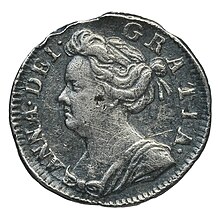History of the English penny (1603–1707)
This article needs additional citations for verification. (May 2009) |
| This article is part of a series on the |
| History of the English penny |
|---|
 |
The history of the English penny from 1603 to 1707 covers the period of the House of Stuart, up to the Acts of Union of 1707 which brought about the Union of the Kingdom of England with the Kingdom of Scotland.
The Stuarts and the Commonwealth (1603–1714)
The Early Stuarts


When
The first coinage, of 1603–4, shows a bust of the king facing right with the inscription I D G ROSA SINE SPINA on the obverse, and a shield including the
In 1625 the 25-year-old second son of James I, Charles I, inherited the throne (his older brother Henry having died before his father). Unfortunately Charles's political judgment was appalling – he reigned for eleven years without convening the Parliament of England, as he was not disposed to accept direction from it when it was sitting, and the ensuing Civil War eventually cost Charles both his crown and his head.

Charles's hammered pennies produced at the Tower originally had a design of a rose on both sides, with the inscription C D G ROSA SINE SPINA on the obverse and IUS THRONUM FIRMAT – Justice strengthens the throne – on the reverse. Later pennies bore a bust of the king facing left with a I behind the head to denote the denomination of one penny, with the inscription CAROLUS D G MA B F ET HI REX – Charles by the grace of God King of Great Britain France and Ireland, while the reverse shows an oval shield and the IUSTITIA THRONUM FIRMAT inscription. Following the takeover of the Tower mint by the English Parliament in 1642, the same coin designs were produced until 1648 though with an older-looking bust of the king; this was to emphasise the fact that Parliaments' argument was not with the king but with his "evil advisors".
In 1638 a new mint was opened at
With the take-over by the English Parliament of the Tower mint in 1642, the king set up his permanent headquarters at
Bristol was captured by the Royalists in July 1643 and a mint was established there, producing pennies with the plume reverse, but it was closed when the English Parliament recaptured the city in 1645. The Exeter mint which operated between 1643 and April 1646 mainly produced crowns and half-crowns, but also made some pennies.
The Commonwealth

The
The Restored Stuarts

Following the Restoration of the monarchy in 1660 in the form of Charles II, both hammered and milled coinage was produced until 1662. The penny was a fairly common denomination and was produced by both methods from dies produced by Thomas Simon. The obverse showed a left-facing bust of the new king with no value indication behind his head, and the inscription CAROLUS II D G MAG BRI F ET H REX – Charles II by the grace of God King of Great Britain France and Ireland. The reverse shows the king's shield over a cross, with the legend CHRISTO AUSPICE REGNO – I reign under the auspices of Christ. This issue marks the end of the English hammered coinage – all subsequent English and British coins have been milled.
The first regular milled silver pennies appeared around 1664 or 1665 and are undated, weighing 0.5 grams and being 12 mm in diameter. They show the king facing left, with I behind the head, inscribed CAROLVS II D G M B F & H REX, and the reverse shows a shield enclosing the
The same basic design continued in the short reign of James II (1685–1688) with the crowned "C" on the reverse replaced by a crowned "I" which acted not only as the king's initial "Iacobus" but as the indication of the denomination, 1 penny.

Following the birth of the Catholic James II's only son
Following the death of Queen Mary from smallpox in 1694 the coins continued with King William's head facing right and the inscription GVLIELMVS III DEI GRA – William III by the grace of God, on the reverse, and the crowned "I" and MAG BR FRA ET HIB REX date – King of Great Britain France and Ireland. Pennies were produced in 1698–1701.
Anglo-Scottish Union

William III was succeeded in 1702 by Mary's younger sister,
Despite having had ten pregnancies, none of Anne's children survived, and the
Anne's reign produced silver pennies in 1703, 1705, 1706, 1708, 1709, 1710, and 1713. The obverse of the coins show her left-facing bust with the inscription ANNA DEI GRATIA, while the reverse shows the crowned "I" and (1703) MAG BR FRA ET HIB REG 1703, (1705,6) MAG BR FR ET HIB REG, or (1708–13) MAG BRI FR ET HIB REG.
References
- Coincraft's Standard Catalogue English & UK Coins 1066 to Date, Richard Lobel, Coincraft. ISBN 0-9526228-8-2
- papist." Mulligan, Tom (1972). Better Coin Collecting. London: Kaye & Ward. p. 13.

